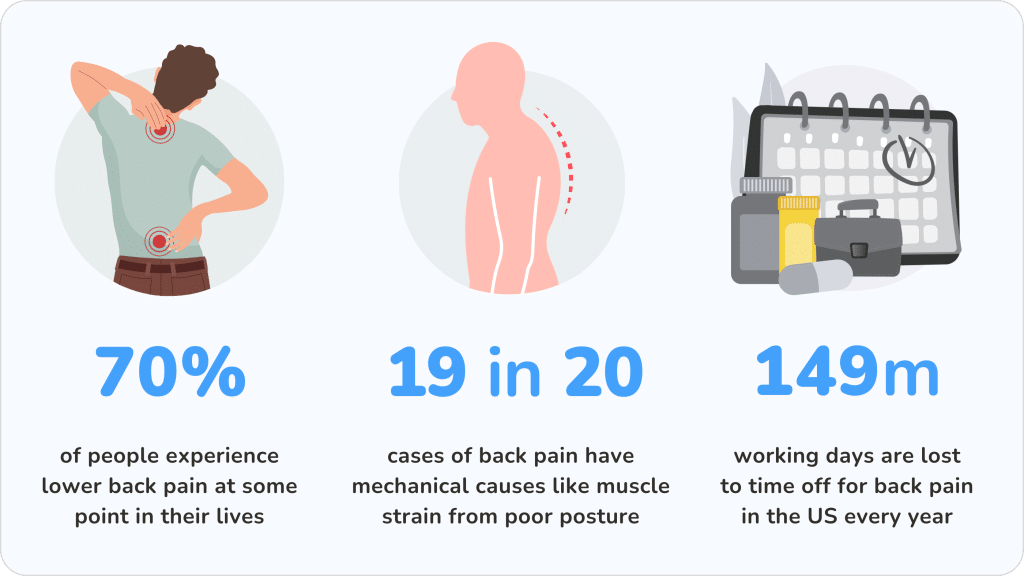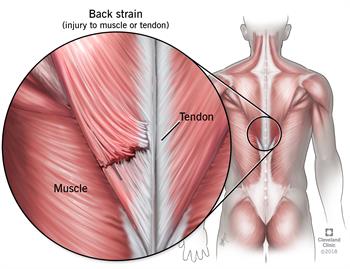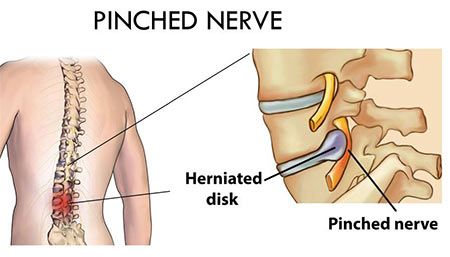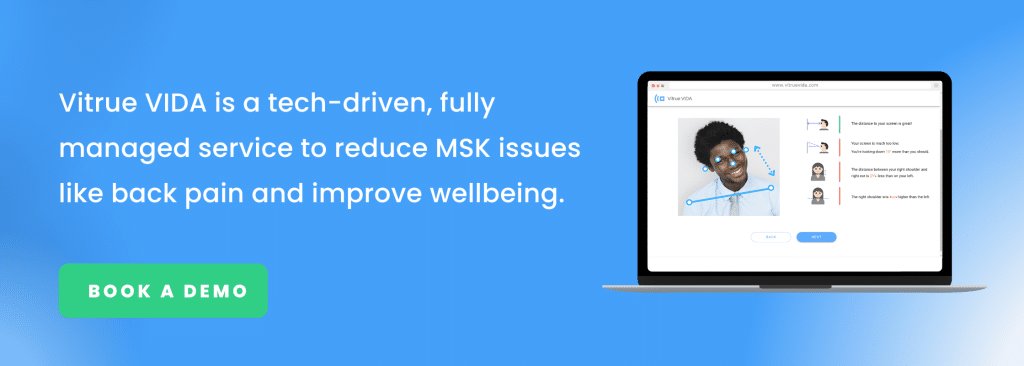You’re working at your desk, typing away at your computer and spending hours on video calls… now you’ve got a nasty bout of back pain.
Back pain is extremely common in desk workers. While many instances of back pain only cause mild discomfort, the more severe cases can have detrimental effects on an individual’s professional, personal and family life. Back pain is one of the top 10 diseases and injuries that account for the highest number of DALYs (life years lost to ill-health, disability and mortality) worldwide.
In the United States, 149 million work days are lost every year due to time off for lower back pain, costing the economy $98 billion. When indirect costs are factored in, this reaches an unfathomable $200 billion annually, two-thirds accounting for lost wages and productivity. In the UK, lower back pain affects one third of adults every year and is the most common cause of disability in young adults.

What are the causes of back pain?
90% of back pain cases are referred to as ‘non-specific’, meaning it’s not possible to pinpoint the exact cause of the pain. 60% to 70% of people will experience non-specific lower back pain at some point in their life.
If your pain lasts for more than 3 months, it’s considered ‘chronic’. The majority of chronic back pain is non-specific, with pain levels varying from mild to severe. Here are some of the most common clinical causes of back pain:
1. Muscle and ligament strains and sprains
Your lower back is surrounded by various ligaments and muscles which support the spine and facilitate movement at the joints. Certain movements, such as lifting a heavy load or twisting, can place excess stress on your muscles and ligaments and injure them. This is the most frequent culprit behind lower back pain.

2. Disc damage
Discs cushion movement between the bones in your spine and absorb excessive forces. If the inner fluid matter of the disc protrudes out, disc prolapse (more commonly known as a slipped disc) can occur. This can cause pain in the area, limit movement and press on the nerves coming out of your spine and into your lower body.

3. Nerve compression
Have you ever felt a painful tingling sensation, along with weakness and numbness in your limbs? If you have, chances are you’ve experienced nerve compression. A slipped disc is often the cause. You may also experience these symptoms if your muscles that run closely to nerves (such as the piriformis muscle in your buttocks region) get tight and press on a nerve, leading to pain and discomfort.

4. Joints and bone issues
The health of your joints, muscles and ligaments are closely linked. Unhealthy joints are frequently associated with weak, painful or overworked muscles. Conditions such as osteoarthritis cause wear and tear in the joints and can lead to a great deal of pain when trying to move.

5. Skeletal deformity
The adult spine has 3 natural curves – in your neck region, mid back and lower back – which ensure proper movement, posture and function of your internal organs. If the curves become abnormal, due to conditions such as scoliosis, increased kyphosis and increased lordosis, this can lead to changes in movement, irritation of your spine structures and pain.

6. Internal organ issues
Many disease or issues relating to internal organs can lead to back pain, such as gynaecological issues in women. Rarer causes of back pain include infections, autoimmune diseases and genetic conditions.

What’s putting desk workers at risk of back pain?
65% of desk workers at the average company are currently suffering with a musculoskeletal issue such as back pain. Here’s what’s causing the pain:
- Prolonged sitting in the same position throughout the working day
- Poor posture most commonly caused by bending forward to look at an incorrectly positioned screen
- Using Display Screen Equipment (DSE) such as computers and laptops for long periods without breaks
- Poor workplace ergonomics (we built our AI desk assessment VIDA to create personalised recommendations to improve your workspace)
- Persistent stress caused by a high workload, tight deadlines and lack of control of your schedule
The risk also increases in the presence of individual clinical factors such as abnormal spinal curves, poor core muscle strength and abnormal mobility. A person is also more likely to get lower back pain if they have already experienced an episode of it before.
Our best back pain solutions for desk workers
For employers:
1. Identify workplace risks
As an employer, you should ensure your team have comfortable workplace setups and take a proactive approach to workplace health and safety. According to the HSE guidelines, you’re also required to identify any employees who may be susceptible to workplace risks and take measures to reduce these risks – VIDA is designed to help you do this at scale!
2. Address Existing Pain
Provide your team with the right strategies and tools to help them manage their pain and self-correct any issues in their workplace setup. The earlier the intervention, the greater the chance of full recovery. VIDA Pain Coach is a personalised pain management program designed to help desk workers recover from existing pain and reclaim their physical wellbeing.
3. Encourage frequent breaks
The DSE Regulations require you to ensure your team take regular breaks throughout the day. Plan rest breaks or changes in activity when necessary and lead by example!
For employees:
1. Move more
Movement and exercise increases blood flow and keeps your muscles, ligaments, joints and bone tissues healthy. Take frequent breaks throughout the working day to stretch your back and change position. Strengthen your core with regular exercise.
2. Prioritise your mental health
If you’re under constant stress at work, this can lead to muscle tension and pain. Discuss your workload with your manager or use an employee assistance program if one is available at your company.
3. Improve your workplace setup
Learn what a good desk setup looks like and which factors can put you at risk. Adopting good working posture will reduce your risk of back pain and help you feel uplifted and energised!
4. Manage your lifestyle
Certain lifestyle habits such as quitting smoking and maintaining a healthy weight can do wonders for reducing and preventing back pain. Simple things like getting a good night’s sleep and soaking in a warm bath can relax your muscles and help alleviate pain.
Most back pain cases are resolvable with physical therapy and time. If you have ongoing back pain or additional symptoms such as leg weakness, tingling or numbness spreading down the legs, changes in bladder and bowel function, see a specialist to get a diagnosis and treatment plan. Act early for the most effective results.





